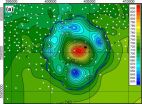(Press-News.org) VIDEO:
Melody Eide, M.D., M.P.H., a Henry Ford Hospital dermatologist and the study's lead author, says regular visits to the doctor may lead to significant reductions in melanoma mortality....
Click here for more information.
DETROIT – The risk of dying from the most dangerous type of skin cancer is significantly reduced with regular doctor visits, according to a Henry Ford Hospital study.
This is believed to be the first study of its kind to link melanoma mortality with routine health care use.
Researchers found that deaths from melanoma dropped 70 percent in patients who had at least one visit to their family doctor or to a specialist in the five years prior to their diagnosis. When factoring in age, gender, socio economics and co-morbidities, mortality decreased by 90 percent in patients who visited a specialist.
Researchers also found substantial reductions in mortality in patients who underwent preventive screenings like a fasting blood test or colonoscopy.
The study is being presented Friday, May 9 at the Society of Investigative Dermatology's annual meeting in New Mexico.
"This study is important because it's not about having health insurance or having access to care. It's about tapping into that care," says Melody Eide, M.D., MPH, a Henry Ford Hospital dermatologist and the study's lead author.
"We know that people are always going to have struggles in their lives. They're going to have unreliable transportation, children that they're caring for, copays that are too expensive to pay. What this study suggests is that these types of barriers may impact your prognosis for cancer if they impede your ability to make your medical care a priority."
While all cancer deaths declined 1.5 percent annually from 2002-2011, the number of melanoma deaths increased 5 percent in the early to mid-1990s but have since leveled off, according to the National Institutes of Health.
However, disparities and poor outcomes exist in melanoma patients who are older, male and from ethnic and lower socioeconomic backgrounds. Researchers sought to examine whether these disparities, when coupled with patients who have insurance and access to care, could be predictors of melanoma mortality.
For the retrospective observational study, researchers reviewed melanoma cases of 251 Caucasian patients from 2001-2007, of which 158 were men. The patients all had health insurance and were eligible for care in a health maintenance organization during the study period. The patients' average age was 60, the age at which patients are typically diagnosed with melanoma.
Surprisingly, researchers found that visiting a specialist prior to melanoma diagnosis may reduce their risk of dying by 90 percent.
"This suggests that these patients who do better may be more engaged in their care or have less outside demands distracting from their care," Dr. Eide says. "It's not just about having insurance and having a doctor you see, it may be about being invested and an advocate for your own health. We found that regardless of their cancer stage at diagnosis, these patients who saw more specialists and had compliance with their fasting lipid panels and other screenings had a better prognosis. This may suggest a role for the patient in improving their health by being engaged and prioritizing their care."
With health care under transformation from the Affordable Care Act, more patients than ever before will have access to care covered by insurance including preventive services without copays. However, having access to care is not the same as using the care available in the community.
In 2012, the percentage of people who had a usual place to go for medical care was 85.8 percent compared to 86.8 percent in 2011, according to the Centers for Disease Control and Prevention's 2012 National Health Review Survey. The survey also found that 6.2 percent of the population failed to obtain medical care due to cost.
"As we have more and more patients becoming insured through opportunities with the Affordable Care Act," Dr. Eide says, "we now have the burden going from not having insurance, to not using the insurance, to not seeking care. The patients in our study all had insurance and in theory all had the same equal opportunities for care. But they received different degrees of care. Some of that may have been at their direction. That is important, perhaps, with cancer prognosis."
INFORMATION:
The study was funded by Henry Ford Hospital, Henry Ford Medical Group and Dermatology Foundation.
Regular doctor visits may greatly diminish skin cancer deaths
2014-05-07
ELSE PRESS RELEASES FROM THIS DATE:
For slumbering diabetics, a way to detect low blood sugar and stop insulin delivery
2014-05-07
STANFORD, Calif. — New research could soon make it easier for people with type-1 diabetes to get a safe night's sleep, says a Stanford University School of Medicine scientist who led the study.
In a large trial conducted in patients' homes in the United States and Canada, scientists demonstrated that they could predict and prevent dangerously low overnight blood sugars in adolescents and adults with type-1 diabetes.
Very low blood-sugar levels can cause seizures or even, in rare cases, death. People with type-1 diabetes often sense warning signs of low blood sugar when ...
Ancient crater points to massive meteorite strike
2014-05-07
EDMONTON—The discovery of an ancient ring-like structure in southern Alberta suggests the area was struck by a meteorite large enough to leave an eight-kilometre-wide crater, producing an explosion strong enough to destroy present-day Calgary, say researchers from the Alberta Geological Survey and University of Alberta.
The first hints about the impact site near the southern Alberta hamlet of Bow City were discovered by a geologist with the Alberta Geological Survey and studied by a U of A team led by Doug Schmitt, Canada Research Chair in Rock Physics.
Time and glaciers ...
Mapping the spider genome
2014-05-07
The fact that the eight-legged creepy spider in some ways resembles humans is one of the surprising conclusions after researchers at Aarhus University and the Beijing Genomics Institute (BGI) succeeded in sequencing its genome.
However, it is more a discovery on an awesome scale. The sequencing has far greater significance for our future understanding of the spider's special properties.
"In brief, we've acquired a tool for everyone interested in spiders," say Kristian W. Sanggaard and Jesper S. Bechsgaard, Aarhus University. Together with Xiaodong Fang, BGI, they are ...
Neural states affect learning
2014-05-07
Theta-band activity in hippocampus after an event seems to be crucial for learning. A study at the University of Jyväskylä also proved that the absence of theta facilitated learning a simple task while training during theta had no effect on learning.
Hippocampus is a brain structure that has a critical role in mammalian learning. The identification of different hippocampal states is based on the oscillatory properties of electrophysiological activity. Traditionally, rhythmic slow activity, theta, has been linked to attention, whereas transient bursts of synchronised neuronal ...
Third US National Climate Assessment reports our ecosystems are already changing
2014-05-07
The US Global Change Research Program released its Third National Climate Assessment (NCA) of the impacts of climate change on biodiversity and ecosystems this Tuesday, May 6. The NCA is the most comprehensive peer-reviewed analysis of climate change's impacts in the United States, informing Americans about the effects of climate change in their backyards.
"As an ecologist, you can't escape the effects of climate change on natural resources. We're observing climate impacts in nearly all natural and managed ecosystems," said Ecological Society of America President Jill ...
Breastfeeding promotes the growth of beneficial bacteria in the gut
2014-05-07
A number of studies have shown that breastfed babies grow slightly slower and are slightly slimmer than children who are fed with infant formula. Children who are breastfed also have a slightly lower incidence of obesity, allergies, diabetes and inflammatory bowel disease later in life. According to a new study by the National Food Institute and the University of Copenhagen this may be due to the fact that breastfeeding promotes the development of beneficial bacteria in the baby's gut.
"We have become increasingly aware of how crucially important a healthy gut microbial ...
Nanoscale heat flow predictions
2014-05-07
Physicists are now designing novel materials with physical properties tailored to meet specific energy consumption needs. Before these so-called materials-by-design can be applied, it is essential to understand their characteristics, such as heat flow. Now, a team of Italian physicists has developed a predictive theoretical model for heat flux in these materials, using atom-scale calculations. The research, carried out by Claudio Melis and colleagues from the University of Cagliary, Italy, is published in EPJ B. Their findings could have implications for optimising the ...
Researchers use DNA to build tool that may literally shine light on cancer
2014-05-07
Bioengineers at the University of Rome Tor Vergata and the University of Montreal have used DNA to develop a tool that detects and reacts to chemical changes caused by cancer cells and that may one day be used to deliver drugs to tumor cells.
The researchers' nanosensor measures pH variations at the nanoscale – how acidic (a higher pH level) or alkaline (a lower pH level) it is. Many biomolecules, such as enzymes and proteins, are strongly regulated by small pH changes. These changes affect in turn biological activities such as enzyme catalysis, protein assembly, membrane ...
Sleep researchers at SRI International identify promising new treatment for narcolepsy
2014-05-07
MENLO PARK, Calif.—May 7, 2014—Neuroscientists at SRI International have found that a form of baclofen, a drug used to treat muscle spasticity, works better at treating narcolepsy than the best drug currently available when tested in mice.
According to the National Institute of Neurological Disorders and Stroke (NINDS), narcolepsy, a chronic neurologic disorder characterized by excessive daytime sleepiness, is not a rare condition, but is under-recognized and under-diagnosed. It is estimated to impact 1 in 2,000 people worldwide.
In back-to-back papers published in ...
Argentina yields 3 new tarantula species
2014-05-07
A team of scientists from the Universidad de La República, Uruguay discovered three native to northern Argentina new species of the engaging spider group of the tarantulas. The study describing the newly found tarantulas was published in the open access journal ZooKeys.
The often hairy and very large spiders known as tarantulas are one of the most famous arachnid groups. Despite their ill fame as vicious killers most tarantulas are harmless to humans. Most tarantulas long lifespans, females can live between 15 and 30 years, which makes them a preferred pet for spider ...






